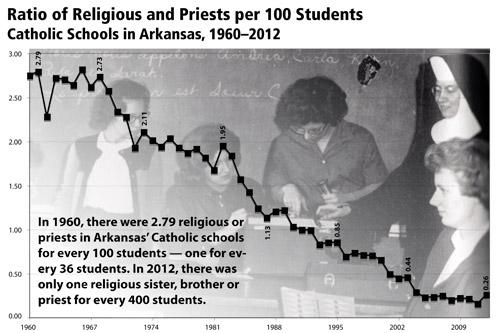

Sister Joan Pfauser, RSM, is a symbol for the current age of Catholic education.
Entering her 27th school year, she’s the lone remaining Sister of Mercy at her alma mater, Mount St. Mary Academy in Little Rock. While she has never served in a time when the school’s faculty was dominated by priests or religious, the guidance counselor has been around long enough to remember double-digit numbers of fellow sisters teaching and in administration.
But she is more than a symbol of receding numbers of religious; she’s also representative of a steadfast optimism about the future of religious life, and its associated ministries, thanks in part to the impact left by the sisters who moved on or retired.
“It doesn’t feel odd to come into this school year,” she said. “There’s something in the walls of this school that preserves that traditional religious feeling. That’s something I credit to our wonderful staff who have taken that foundation that the early sisters laid and built on it.”
Across the Diocese of Little Rock, as with most of the United States, the number of priestly and religious teachers is down. The National Catholic Educational Association reported a full-time equivalent of 3,341 sisters, 737 brothers and 775 priests taught in U.S. Catholic schools last year. This represents 3.2 percent of the total 151,405 full-time equivalent teachers, less than half of what it was in 2000.
In Arkansas, in the 2012-2013 school year only 12 full-time and five part-time teachers were either priests or religious. Excluding pastors, eight schools of the 28 schools in the diocese list a priest or member of a religious order in a teaching, administrative or support role: Subiaco Academy; Mount St. Mary Academy, Catholic High School and St. Edward School in Little Rock; Blessed Sacrament School in Jonesboro; St. Michael School in West Memphis; St. John School in Hot Springs; and Immaculate Conception School in Fort Smith.
For the first time in the modern educational era, the diocese reported no priests as full-time teachers, according to NCEA criteria.
Despite such sobering statistics, Sister Joan said Catholic schools such as Mount St. Mary, in concert with parish and diocesan youth ministry, continue to do a good job in the faith formation of students.
“I have never seen such growth in our students’ relationship with God as I have over the past five years,” she said. “They’re not afraid to talk about their faith as foundational in their lives. In years past, you almost had to drag that out of them.
“Would I rather see (young women) in a committed religious life, of course, I would much rather see that. But these young women deeply love the Church and it makes me hopeful for the future.”
Sister Lisa O’Connell, OSB, principal of Blessed Sacrament School in Jonesboro and the lone religious among the state’s Catholic school principals, echoes Sister Joan’s optimism, saying she senses “a new springtime” in the number of women called to religious life and therefore to ministries that include education. She cited her own community, Holy Angels Convent in Jonesboro, as a prime example with two novices, two postulants and soon to welcome a third.
Such increases, while isolated, fly in the face of the assumption that lack of religious in the classroom automatically dampens women’s vocations. Sister Lisa said while it is undeniably helpful for youngsters to see sisters up close, many new discerners today take their first steps to discernment via the Internet anyway. She also points to the “hidden” religious involved in Catholic education who don’t make it into the headcount, but support its mission nonetheless.
“We have a couple of retired religious who are serving as tutors here and there are some who are doing that in Little Rock, too,” she said.
Like Sister Joan, Sister Lisa gives a lot of credit to lay teachers and administrators who continue to achieve results, including in faith formation, among Catholic students in Arkansas. It’s something she has seen up close in each of her three parochial stops over 13 years in education.
“I’ve always been supported by other teachers and I have to say that I am so edified by the work that the lay principals are doing. They are making true sacrifices and I am so impressed by all of them,” she said.
This more pronounced role of the laity hasn’t happened by accident. Diocesan schools have consistently maintained high percentages of practicing Catholics in teaching positions; the Catholic Schools Office reports 81 percent of elementary teachers and 66 percent of secondary teachers in Arkansas’ parochial schools are Catholic, a number that has remained relatively constant for years.
From this foundation, the diocese has implemented rigorous continuing education for teachers in the area of religious instruction. And, principals are exploring ways teachers can deliver practical religious instruction, as well as theoretical.
“We have a lot of conversations as a faculty about how to lead students to a deeper prayer life,” said Ileana Dobbins, principal of Our Lady of the Holy Souls School in Little Rock. “Past the prayers we teach them and that we say every day, we want them know how to turn to prayer on their own when they are in trouble or need guidance. That’s different for an eighth-grader than it is for a fourth-grader.”
Dobbins said while the environment at Holy Souls is “different” since 2010 when the Olivetan Benedictine nuns ended their 83-year tenure there, a more pronounced religious presence exists than the official statistics would suggest. Last year, Pastor Father Erik Pohlmeier and Father Philip Reaves taught religion classes in the school on a rotating basis that ensured every class, down to pre-kindergarten, experienced being taught by a priest.
“Having the sisters here gave the kids a sense of awe about religious life and brought it home to them,” she said. “Father Erik and Father Philip were great; we were blessed to have them continue that presence.”
Steve Straessle, principal of Catholic High School, said even one religious person in a school can have a profound impact on the entire system. He said while lay teachers daily distinguish themselves as people of faith, the visible example of giving one’s life totally over to God is something that cannot be duplicated.
“I remember when Bishop (J. Peter) Sartain called me about this job,” Straessle said. “I’m not in the habit of interrupting bishops, but I did that one time when I told him that it was my belief that a priest should be principal of Catholic High. I think a tangible symbol of faith is that powerful.”
Straessle, who experienced the administration of the late Msgr. George Tribou as a student and a teacher, said as principal he continues to be deeply influenced by the school’s religious faculty, rector Msgr. Lawrence Frederick and counselor Brother Richard Sanker, CFP.
“Father Fred, Brother Richard and I speak regularly, not just once in a while, regularly,” he said. “As a principal, I’m seeking how to philosophically, emotionally, psychologically and spiritually serve the students I’m charged with. Their experience and input is invaluable.”
For his part, Brother Richard remains philosophical about the state of religious in Catholic schools. One the one hand, he feels intimately the loss of many of his religious brethren, remembering days of teaching on an almost exclusively religious staff at the now-defunct Morris School for Boys in Searcy. On the other hand, he marvels at the wonderful example his lay colleagues demonstrate.
“Obviously, the camaraderie, the brotherhood is something I miss greatly,” he said. “I think the lack of religious means there is less understanding of vocations. At the same time, we have some really, really fine teachers here who serve as witnesses in their own vocations to their students and to their families. And that is something that is marvelous.”
Please read our Comments Policy before posting.
Article comments powered by Disqus Winning directory photo honors Our Lady of Guadalupe
Winning directory photo honors Our Lady of Guadalupe
 St. Paul says: How does the Bible define love?
St. Paul says: How does the Bible define love?
 6 steps to getting married in Diocese of Little Rock
6 steps to getting married in Diocese of Little Rock
 Most frequently asked questions on Catholic marriage
Most frequently asked questions on Catholic marriage
 St. Joseph a model of solidarity with immigrants
St. Joseph a model of solidarity with immigrants
 Two gifts after Jesus’ death: Virgin Mary and Eucharist
Two gifts after Jesus’ death: Virgin Mary and Eucharist
 Why we have an altar, and not just a communion table
Why we have an altar, and not just a communion table
 Pope: Wars should be resolved through nonviolence
Pope: Wars should be resolved through nonviolence
 Living relationship with Jesus Christ in the Eucharist
Living relationship with Jesus Christ in the Eucharist